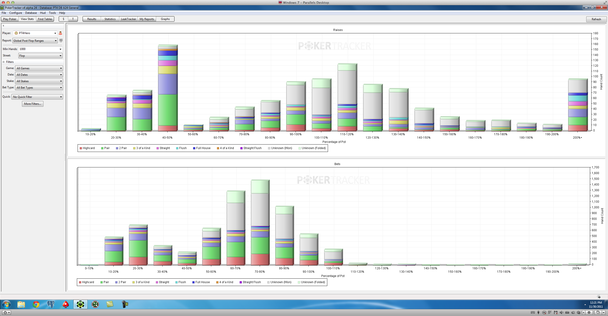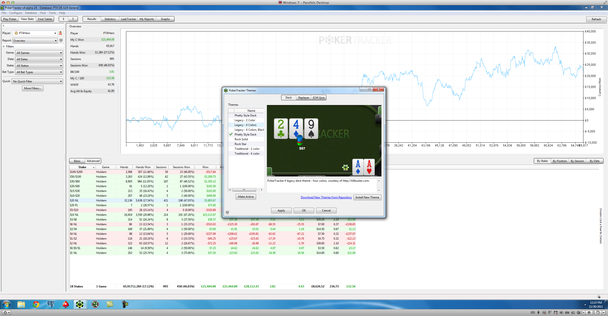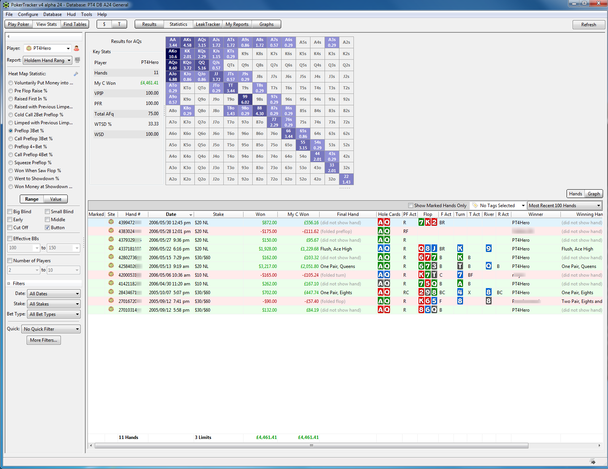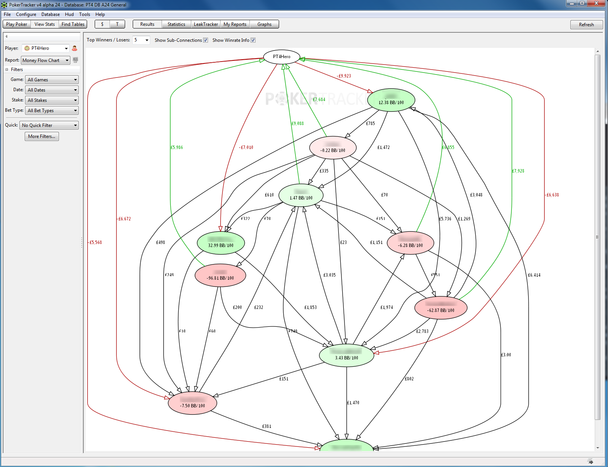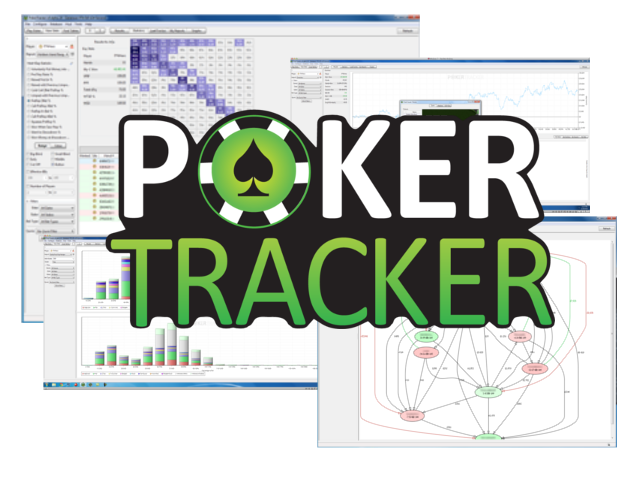
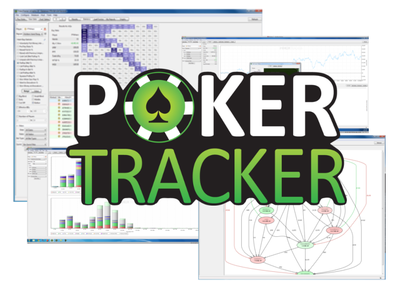
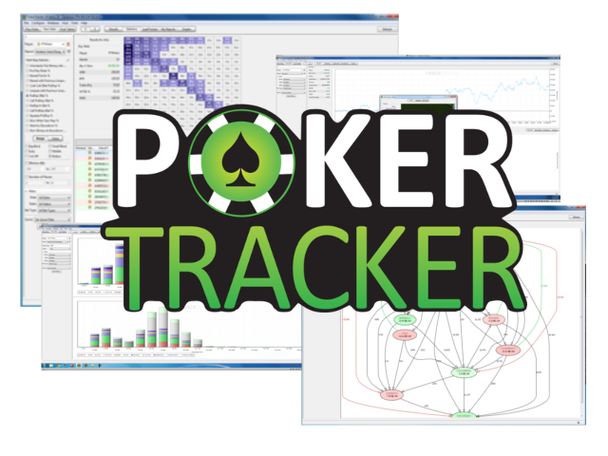
I recently received an exclusive and extensive inside look at PokerTracker 4. I came away with the vision of a company with its sights set on the future of online poker. “With competitors entering the database arena, PT3 was rushed to market … PokerTracker 4 will be different” The simplest change from PokerTracker 3 to PT4 is one of the most telling. It’s no longer all about the Benjamins. The world no longer measures poker success in just dollars and cents. It can also be measured by Euros, pounds, or any number of local currencies.
With PokerTracker 4, you no longer have to view your overall results in dollars. With a click, you can switch between dollars, pounds, Euros, and any other common currency. As more and more sites add multiple currency options at their tables, it makes sense for a tracking program to help the user make sense of these currency conversions, automatically providing daily exchange rates. With many countries carving out their own segregated markets and the US no longer driving online poker, this is in fact essential. Poker has become an international game.
PokerTracker takes this to its logical conclusion by pricing their product in Euros. Of course, you can still spend dollars to purchase it, but their price point will be defined by the Euro.
But enough talk of exchange rates and international politics. Let’s talk stats. PokerTracker 4 includes some new stats, boasts an improved custom-stats editor, and redefines some old standbys. They’ve also staunchly refused to add some other hotly requested new stats.
Along with all of the old 3Bet, 4Bet, and Fold To 3Bet stats, PokerTracker 4 adds 3Bet v. Position stats. Now you can see exactly how often a player 3-bets against, for instance, a hijack raiser. There is also a full complement of stats in the Heads Up Display (HUD) for post-flop behavior in 3-bet pots compared to non-3-bet pots.
“If PT4 doesn’t have enough stats for you, there are always custom stats. In PT3, it was difficult to create your own stats without a background in computer programming. With the new custom stat editor, anyone should be able to create their own.” VP$IP has been renamed VPIP and redefined to no longer include big blind walks in its calculation. While this may seem trivial, it brings up another new feature of PT4. Each stat is defined within the program, both in layman’s terms and by the exact code defining the statistic. There are also embedded help videos to assist the user in using the stat. Various tracking programs often have differing definitions for the same stat, but PT4 will actually tell you exactly what you’re looking at.
Rake can be measured in PT4 four different ways: attributed, contributed, taken, and share. To be honest, I’m still a bit fuzzy on how a couple of these rake stats are defined. The good news is that PT4 will tell me just that the next time I use it. With all the different ways of calculating rakeback, it’s important for a tracker to be flexible in this way.
While PokerTracker has listened to its users and added a boatload of new features, the one hotly-requested feature not included in PT4 is versus-hero stats. PokerTracker actually created those stats and subsequently junked them. That’s right; they’re deliberately not included in PT4. Why? After consulting many experts, the people at PokerTracker believe these stats will do more harm than good, largely due to sample-size and data-skewing issues. Since your relative position against a particular player is more or less fixed at a given table, versus-hero stats can be heavily skewed by circumstance. Due to seat selection preferences, you can’t even assume that this relative position will even out in the long run. Throw in the fact that a given player will only 3-bet you in a small fraction of hands played together, and you have the recipe for a very misleading statistic.
Instead of delivering versus-hero stats, they’ve pointed the user towards 3Bet-versus-position stats, which should provide a more accurate profile of the user’s opponents. Whether or not you agree with their sample-size and data-skewing concerns, it’s a rare thing for a company not to deliver something its customers want simply because it may cause harm. If the tobacco industry operated this way, well, there would be no tobacco industry.
If PT4 doesn’t have enough stats for you, there are always custom stats. In PT3, it was difficult to create your own stats without a background in computer programming. With the new custom-stat editor, anyone should be able to create their own.
“So when will PT4 be released? There is no firm release date yet, and that’s a good thing. No one wants a product that was rushed out for the holidays. 'Soon’ is the best answer I received.” As for things that won’t be included in PT4, the auto-rate feature has been removed from the program. Sort of. The truth is that auto-rate has been excised, re-imagined, and replaced. This gets back to the philosophy of denying features that PokerTracker believes can harm the user. In this case, auto-rate can lead to lazy and confused poker. Instead of auto-rating players, users can now define their own filters to tag opponents. Where auto-rate slotted opponents into rigid boxes, tags allow the user to note specific characteristics of their opponents. These tags can be automated by creating special filters to search for tendencies. The user can also manually apply tags to their opponents as they get to know them. The key difference between the old PokerTracker icons and the new PT4 tags: a player can be assigned multiple tags.
This brings us to the vector HUD engine. Don’t mistake this for vector graphics. The HUD uses fonts, but instead of resizing them using 8 pt, 9 pt, or whatever, PT4 has the GPU redraw the fonts to stay perfectly proportioned with your tables. That means no more awkwardly sized HUD panels blocking table action or stack sizes.
PokerTracker 3 came with a default HUD that was designed to be more of an inspiration than a solution. The thought was that most players would use the powerful HUD editor to design their own custom HUDs. It turned out that the majority of poker players are either too lazy or unmotivated to put the time into developing a HUD that fits their exact needs. Listening to the people, PokerTracker recruited the help of professionals like Ben Lamb, noted author Jeff Hwang, and many others to build a robust default HUD. While the option still exists to create your own, one look at the prepackaged HUD may persuade you not to.
It’s easy to switch between lifetime and session stats, and hovering the cursor over each stat in the HUD provides a description of said stat along with sample size information. The PT icon at the top of the table lets you turn the HUD on and off for each table. With two clicks you can export a hand history to file, forum, or social media. The icon also allows you to review hands from the current session, viewing street by street equity in hands that reached showdown.
Instead of marking hands for later review, PT4 allows you to tag them. That provides all the benefits of marking, but with descriptive and filtering abilities. You can use different colored tags to represent particular types of hands: good hands, bad hands, questionable hands for review, brag hands to show your friends, relevant hands for coaching, significant hands for opponent reads/taking notes, etc. You can define these tags however you want, and they work just like any other online tag, meaning you can assign more than one to a given hand. So a hand could be both opponent-read related and questionable for your own review. You can even tag the current hand as its being played, so you can make a live note every time you encounter a particularly tough decision. You can also set up filters to auto-tag hands that meet user-defined criteria.
While database programs can be great tools while you’re actually playing, their most fundamental function comes in self-review, and this is where PT4 really shines. Of course the hand replayer includes street by street equity. It also contains a hand range model creation tool, which allows you to discount hands (i.e. you can say the player will only have AA/KK half as often as theoretically possible, because they might play them another way half the time). You can even build preset ranges to test your equity against.
The Hand Range Visualizer, which also functions on your own tendencies, lets you toggle between how often you play a particular hand one way and what percentage of your range that hand comprises. If you’re getting a bit lost in my explanation, don’t worry. The program has an embedded help video to assist you with it.
Speaking of videos, while you’re busy reviewing your hands, PT4 can render them as videos, uploading them to YouTube if you choose. 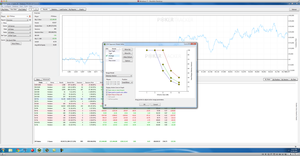 This social media aspect runs throughout the design of PT4, showing an understanding that even online poker players are not solitary creatures.
This social media aspect runs throughout the design of PT4, showing an understanding that even online poker players are not solitary creatures.
In addition to studying ranges and equities, you can test your ICM knowledge with PT4. It has built-in quizzing tools and shows your push/fold equities. This removes the need for yet another outside program. You can also perform ICM analysis on hands you’ve already played in tournaments or Sit-N-Go’s.
Included in PT4 is LeakTracker, which allows you to compare your own stats to PokerTracker’s enormous database. In a series of graphs, you can see where your own stats reside on the spectrum of winning players.
Many of the existing features of PokerTracker have become more visual in PT4. While the versus-player tab has always existed, now you can see the money flow in vivid color. And about those colors: PT4 has moved away from the traditional green and red lines. With almost 10% of the male population experiencing color weakness (or red/green color blindness), a significant number of players have been thought of here.
One very good looking feature is the ability to filter by graph zoom. While checking out your graph, you can click and drag to select a subsection of the graph, which will then become the timeline for a new graph. By zooming in on sections of your graph, you will be filtering your hands by time. Those hands will be listed below the new graph, where you can sift through them and review or tag the ones you’re looking for.
While all of these new features may be exciting, the biggest area of improvement from PT3 to PT4 is the user interface. PokerTracker’s goal is to assist the player’s workflow, not to interrupt it. Everything is designed to be more user-friendly and intuitive. The database vacuums and analyzes itself as you import. Hands are viewable as they come in live. You won’t always need to refresh every time you change a filter. You can configure mucked cards on your HUD while you play. Stats have descriptions and help videos.
So when will PT4 be released? There is no firm release date yet, and that’s a good thing. No one wants a product that was rushed out for the holidays. “Soon” is the best answer I received. Keep your eyes open for the beta release date later this month.
When PokerTracker 3 was released, it had a lot of problems. Every program will have some bugs, but only a handful of sites were supported by the first versions of PT3, and whether or not the HUD worked was a coin flip. The program represented a complete overhaul of PT2, built on a new programming platform. In fact, it wasn’t even built by the same company. (Literally – PokerAce HUD bought out PokerTracker between the release of PT2 and PT3.) With competitors entering the database arena, PT3 was rushed to market. Over time it became a very solid product, but even PokerTracker admits the initial release was a bit of a fiasco.
PokerTracker 4 will be different for two main reasons. First of all, the company has learned from its experience. Second, the program is built upon the foundation of PT3. If you don’t believe them, you can always try out their product without spending a dime (or euro), as they currently offer a 60-day free trial period for PT3. The trial period for PT4 will be 30 days, but purchase of PT3 currently comes with a free upgrade to PT4 upon its release.
I’ll leave you with a quote from PokerTracker representative Steven McLoughlin, who provided this extensive tour of PT4. “PokerTracker 4 is not perfect, but we want to achieve that goal someday by continuing to develop improvements for the application after it is released. Our mind’s eye has a vision that is so mind-blowingly incredible, it would take us decades to complete developing to meet that vision. We know what players need, and we’re trying to give the widest number of options to the widest number of players…. now.”

